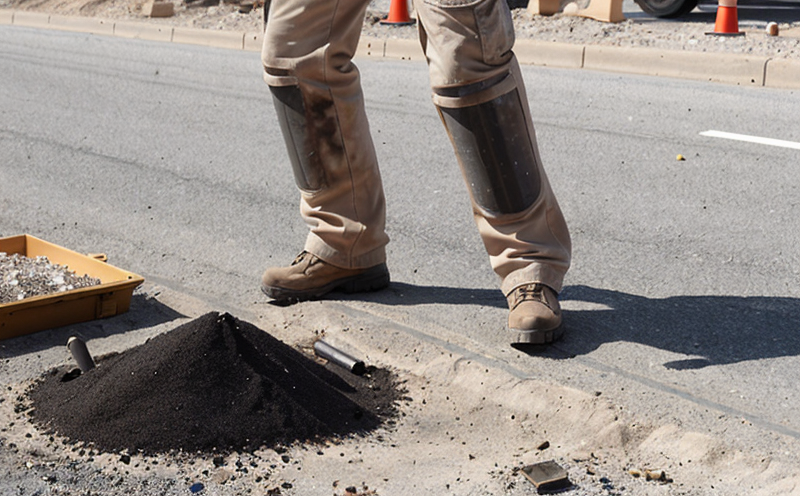IME Standard 19 Field Detonation Velocity Testing of Explosives
The IME Standard 19 test focuses on quantifying the detonation velocity of explosives in a field setting, which is crucial for ensuring safety and efficiency in mining operations. This standard provides a framework to evaluate how quickly an explosive can propagate through various media such as rock or coal, which directly impacts drilling and blasting activities.
The IME Standard 19 test involves placing the explosive specimen into a borehole of specified dimensions. The detonation is initiated, and the velocity at which the shockwave travels along the borehole is measured using sensors positioned at known intervals within the hole. The primary goal of this testing method is to ensure that explosives perform as expected under field conditions.
Understanding the detonation velocity helps in selecting appropriate explosives for specific mining tasks. For instance, a higher detonation velocity might be preferred when rapid excavation or tunneling is required. Conversely, a lower velocity could be more suitable for precision blasting in areas where environmental impact needs to be minimized. This standard ensures that the selected explosive meets safety and performance requirements as defined by international regulations.
Field detonation velocity testing also plays a vital role in compliance with local mining codes and standards. Regulatory bodies often require documentation of these tests to verify that the explosives used are safe for use within specified operational parameters. Compliance officers responsible for ensuring adherence to such regulatory frameworks find this test particularly useful as it provides necessary data for certification purposes.
R&D engineers benefit significantly from IME Standard 19 testing because they can use the results to refine formulations and improve performance characteristics of new explosives. By understanding how different ingredients affect detonation velocity, engineers can develop safer, more effective products tailored specifically for mining applications. Additionally, this information aids in optimizing blast designs which enhance both productivity and safety during operations.
Procurement teams involved in sourcing explosives for large-scale mining projects appreciate the standardized approach provided by IME Standard 19 as it establishes clear criteria against which suppliers must meet or exceed when delivering their products. This ensures consistency across batches from different manufacturers, thereby reducing variability risks associated with variable quality control practices.
Through rigorous adherence to IME Standard 19 testing protocols, mining companies can establish confidence in the reliability and safety of their explosive materials. Such confidence translates into better planning for operations, improved worker safety measures, and ultimately contributes towards sustainable development goals within the industry.
Applied Standards
The IME Standard 19 field detonation velocity testing protocol aligns closely with international standards such as ISO 4850:2017 which specifies methods for determining the shock wave velocity in granular materials. By adhering to these widely recognized guidelines, laboratories performing this service ensure their results are comparable and acceptable globally.
Additionally, compliance with EN 369-1:2018 pertaining to safety aspects of explosive substances also supports accurate measurement practices during detonation testing. These European standards emphasize the importance of proper equipment calibration and operator training which further enhances data accuracy.
The IEC TC 7A SC 7A/NP 55 document provides essential insights into the design considerations for electric blasting caps used in conjunction with IME Standard 19 tests. Understanding these factors helps to minimize potential errors that could arise due to improper equipment selection or usage.
ASTM E368-04(2017) offers another valuable resource for those conducting field detonation velocity measurements. This American Society for Testing and Materials standard outlines procedures for assessing the sensitivity of explosives, including their susceptibility to accidental initiation from external stimuli like mechanical impact or heat sources.
By integrating these international standards into laboratory practices, testers can provide reliable data that meets stringent industry requirements while fostering trust among all stakeholders involved in mining activities.
Scope and Methodology
The scope of IME Standard 19 field detonation velocity testing encompasses a detailed examination of the explosive's performance characteristics under realistic field conditions. This includes evaluating how effectively an explosive can propagate through various media, such as rock or coal, which is critical for determining its suitability for specific mining applications.
- Specimen Preparation: Explosive specimens are carefully prepared according to specified dimensions and weight requirements outlined in the standard. Proper preparation ensures consistent results across different tests.
- Borehole Creation: A borehole is created using appropriate drilling techniques ensuring that it meets the predefined specifications regarding depth, diameter, and orientation. The integrity of the borehole directly influences the accuracy of velocity measurements.
- Detonation Initiation: Detonation initiation occurs via controlled electrical or mechanical means depending on the type of explosive being tested. Careful calibration of detonators ensures precise timing which is crucial for accurate velocity calculations.
- Sensor Placement: Sensors are strategically placed within the borehole at predetermined intervals to capture the shockwave propagation data accurately. Their positions and configurations play a significant role in determining the final results.
- Data Collection & Analysis: Once detonation has been initiated, sensors record the time taken for the shockwave to travel between successive points along the borehole. This information is then analyzed using specialized software tools designed specifically for processing such data sets.
The methodology employed in IME Standard 19 testing ensures that all variables affecting velocity measurement are accounted for, leading to reliable and repeatable results. These results can be used by mining professionals to make informed decisions about explosive selection based on real-world performance metrics rather than theoretical values alone.





